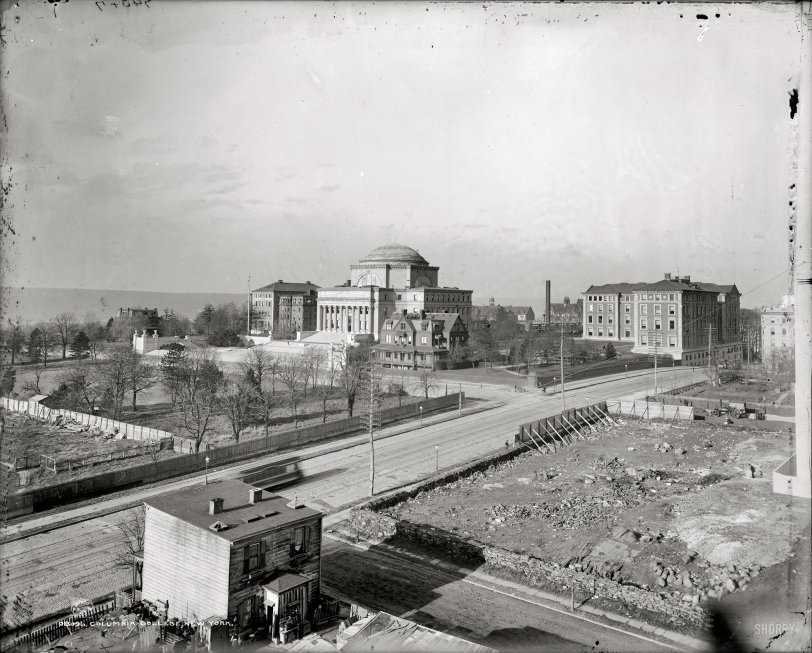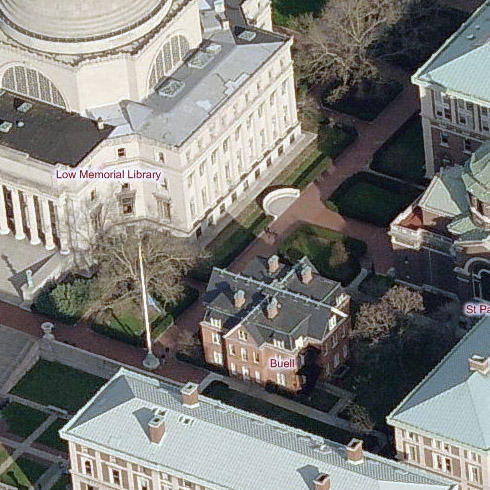


Framed or unframed, desk size to sofa size, printed by us in Arizona and Alabama since 2007. Explore now.
Shorpy is funded by you. Patreon contributors get an ad-free experience.
Learn more.

- What a headache!
- Baldwin 62303
- Baldwin VO-1000
- Cold
- No expense spared
- Tough Guys
- Lost in Toyland
- And without gloves
- If I were a blindfolded time traveler
- Smoke Consumer Also Cooks
- Oh that stove!
- Possibly still there?
- What?!?
- $100 Reward
- Freeze Frame
- Texas Flyer wanted
- Just a Year Too Soon
- WWII -- Replacing men with women at the railroad crossing.
- Yes, Icing
- You kids drive me nuts!
- NOT An Easy Job
- I wonder
- Just add window boxes
- Icing Platform?
- Indiana Harbor Belt abides
- Freezing haze
- Corrections (for those who care)
- C&NW at Nelson
- Fallen Flags
- A dangerous job made worse
Print Emporium
Columbia U: 1897

"Columbia College, New York." The Low Memorial Library in a circa 1897 shot of Columbia University's Morningside Heights campus. Note the steamroller (or whatever that is) to the right. Detroit Publishing glass negative. View full size.
LOVE THIS PHOTO!
My sister went to Columbia U. in the 1980's and still lives a few blocks away from here (West 110th). I love walking around the campus. I am FASCINATED by this photo...can't wait to go back to walk the campus again!
Bloomingdale Insane Asylum
One more... Here's a map of the campus when it was the Bloomingdale Insane Asylum:

Superintendent's House
The mansard roofed building in the background was the superintendent's house for the Bloomingdale Insane Asylum. It housed the music department when Columbia first took over the property and later served as the Men's Faculty Club. The building was demolished in 1922 to make way for Dodge Hall, which today also houses the Music Department.
Amazing
Having attended Columbia in the late 70s/early 80s, I find this to be an amazing photo. I lived in Johnson Hall (now Wien Hall), to the right of the area where, as one of the other posters noted, the Law School is now across Amsterdam from the Library. I also recall that the building had a 1912 date on it, and of course that seemed ancient at the time. Now I see a photo taken 15 years before the construction of the dorm. And the famous and beloved cobblestoned "Walk" at 116th Street hasn't even been laid yet! That's 116th running in front of the house where the man is working on something. Thank you Shorpy!
Bedrock Community
The block in the lower right corner of the photo is bounded by a beautifully made old farm-style dry stone wall, and there appears to be a natural outcropping of the underlying bedrock in the extreme lower corner of the image, textured with linear glacial scouring quite like that on the outcroppings in Central Park. Is there anyone in the Legion of Shorpy Archive Aces who might know what was on this lot before it was cleared for the university expansion? The stone wall doesn't look as if it was built as a construction barrier, and would seem to predate the surviving wood frame house in the adjacent block. The six-over-six sash windows, the broad shiplap siding and interior chimneys on that house suggest that it is pretty old itself, perhaps 1840s-1860s, or even a bit older.
Street work
In addition the the steamroller you can see men working on the street. In fact, just in front of the machine you can see the top half of a man who appears to be holding some sort of tool in a ditch.
Buell Hall
Buell Hall was originally named Macy Villa, after benefactor William H. Macy (of department store fame). The building is the last remaining part of Columbia's predecessor, the Bloomingdale Insane Asylum. Macy Villa housed wealthy male patients, who were separated from regular folks.
[William H. Macy is an actor. The department store you're talking about was founded by Rowland Hussey Macy, a Nantucket Quaker who started out as a whaler. - Dave (thanks to A.T.)]
Columbia's law school now stands in the lot just north of the tractor thing. The blocks beyond were tenements for much of the 20th century. The novelist Oscar Hijuelos was raised two blocks away on 118th Street. Those tenements were replaced in the 1960s by the International Affairs Building, which houses the School of International and Public Affairs, whose most famous graduate will be sworn in as president January 20.
That sinking sensation
In the original photo, the ground floor of Buell Hall looks half-sunk in the landscape. Did they raise the house later? Lower the grounds? Strange.
[I think you have it backward. They raised the grounds. That's the basement level (partly obscured by a fence) in the 1897 photo, which is no longer visible in the current view. - Dave]
Telephone wires
I love this photo for all the reasons that have already been mentioned. I love how it captures people in their late afternoon routines, with some buildings still there and others long gone. A slice of time that has something different for each viewer.
For me, the phone poles are interesting. Back in those days when telephones weren't so common or cheap, one pair of wires could carry only one conversation. This led to phone poles that carried hundreds of pairs, this was both unsightly and expensive. After a certain distance, the wires in each pair had to be swapped over to prevent crosstalk.
All this changed very quickly, with the introduction of carrier multiplexing around WWI. A single phone pair could now carry multiple conversations and phone systems became significantly cheaper to install and maintain.
As always, can't wait for tomorrow's pics.
Amsterdam Ave.
According to Google Naps, the land in front of that brick building on Amsterdam Avenue has been regraded, and there's now a bridge/tunnel over that entire block where the building is (though the building itself is still there. Sadly, the beautiful mansion in front of the library is gone, and it appears that the mansard roofed house further beyond the library is also gone. Where the shack in the foreground is appears to be a large apartment style building; there is absolutely no view of the library from anywhere close to that spot this picture was taken today.
BTW, this is my first post as a REGISTERED user, though I think it's somewhere around post 100 total. Thanks for the great site Dave; maybe when "old photos" finally reach the very late 1960s and early 1970s some of my own photos will start showing up.
[The "beautiful mansion" (Buell Hall) is still there. - Dave]
Road Construction
Also notice behind the rock-strewn lot on the right that the road is being Macadamized--you can see the steam roller and a pile of gravel behind it.
Lou Gehrig
If you had come by this scene around 1924, you might have seen Lou Gehrig playing baseball for Columbia in the large field right in front of the Library.
It's also interesting to see (I believe) the towers of Teachers' College in the background. I live here from around 1947 to 55. Many changes.
Fabulous
Wonderful image. So many things to look at in this shot. Just look at the size of the telephone pole! I wonder why the windows are open in the house in the foreground. It appears to be a winter day.
Looks like Springtime!
It's bright, sunny and those little flowerpots wouldn't be outside on the table behind the house if the last frost hadn't already occurred - and neither would the guy nearby in his shirtsleeves. I'm particularly struck by how 'clean' Amsterdam Avenue appears.
Wow!
Almost no construction on upper Broadway -- you can see clear through to the river! That's obviously Amsterdam Avenue in the foreground. Love the streetcar and the little house!
A Matter of Cropping
With the intent of the photographer to record the magnificence of the Library, it's interesting that he also gave us a view of a rather rough-hewn structure in the foreground, complete with a man bent over some sundry task; as well as a nice row of scrap piled along a fence; yet these details are full of interest for us today.
Paradox?
One would assume that a photo of this era would have required the shutter to be opened a long time, as evidenced by the blurred streetcar. However, we have a gent bent over something in the back yard (lower left). Either he was bent over for a long time (slow shutter speed) or that streetcar was really booking!
[Shutter speeds for outdoor exposures made with view cameras of this vintage were generally fractions of a second. Shutter speeds on inexpensive Kodak box cameras were demarcated in hundredths of a second. - Dave]
Slices of time
I love these candid slices of time. The camera caught a man looking for treasures(??) out in the empty lot and another man behind the house doing some sort of chore! There's always so much to look at in these pics. Thanks, Shorpy!

























On Shorpy:
Today’s Top 5